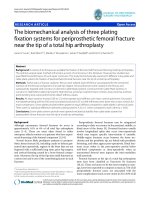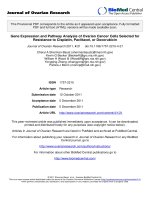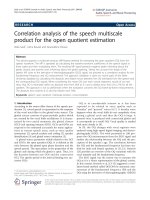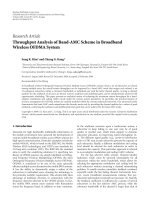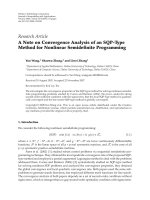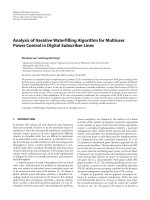Design and analysis of rectifying circuits and antennas for wireless power transmission and ambient RF energy harvesting
Bạn đang xem bản rút gọn của tài liệu. Xem và tải ngay bản đầy đủ của tài liệu tại đây (6.78 MB, 172 trang )
DESIGN AND ANALYSIS OF ANTENNAS AND
RECTIFYING CIRCUITS FOR WIRELESS POWER
TRANSMISSION AND AMBIENT RF ENERGY
HARVESTING
SUN HUCHENG
(B.Eng., University of Science and Technology of China, P.R.C)
A THESIS SUBMITTED
FOR THE DEGREE OF DOCTOR OF
PHILOSOPHY
DEPARTMENT OF ELECTRICAL AND
COMPUTER ENEGINEERING
NATIONAL UNIVERSITY OF SINGAPORE
2014
DECLARATION
I hereby declare that the thesis is my original work and it has been written by me in
its entirety.
I have duly acknowledged all the sources of information which have been used in
the thesis.
This thesis has also not been submitted for any degree in any university previously.
__________________
Sun Hucheng
17 April 2014
i
Acknowledgements
First of all, I would like to express my sincere gratitude to my supervisor, Prof.
Guo Yongxin, for his invaluable guidance and constructive support throughout my
doctoral study. Without his professional guidance and inspiration, this thesis would
not be possible.
I am deeply grateful to Dr. Zhong Zheng, for his detailed and constructive
comments and help on my works. I also would like to thank Mr. He Miao, who has
been a collaborator of some works, and a co-author of some of my papers. It was
great pleasure to work with them.
I would like to thank my friends in Microwave Research Laboratory, who have
been very kind and supportive in my research life, especially Mr. Agarwal Kush, Dr.
Bao Xiaoyue, Dr. Bi Xiaojun, Dr. Chu Hui, Dr. Duan Zhu, Miss Lei Wen, Mr. Liu
Changrong, Mr. Long Yunsheng, Miss Ren Rui, Dr. Wang Lei, and Miss Xu Lijie.
My graduate life at NUS would not have been fun and interesting without them.
Many thanks go to all the staff of Microwave Research Laboratory and ECE
Department, especially Mdm. Guo Lin, Mdm. Lee Siew Choo, and Mr. Sing Cheng
Hiong for their kind assistances in all the technical and administrative support.
My deepest appreciation goes to my family. My parents gave much love, and their
continuous encouragements are my great source of power, which enables me to
overcome the frustrations in writing this thesis. This thesis is dedicated to them.
Finally, I would like to thank all people who have helped and inspired me through
my doctoral study.
ii
Table of Contents
Acknowledgements i
Table of Contents ii
Summary v
List of Tables vii
List of Figures viii
List of Acronyms xii
Chapter 1 Introduction 1
1.1 Background and Motivation 1
1.2 Literature Review 5
1.2.1 Rectennas for Low-Input-Power Applications 5
1.2.2 Rectifiers With Wide Operating Input Power Ranges 9
1.2.3 60-GHz Rectennas 11
1.3 Thesis Outline 13
1.4 Original Contributions 17
1.5 Publication List 19
1.5.1 Journal Papers 19
1.5.2 Conference Papers 20
1.5.3 Patents 21
Chapter 2 Technology-Independent Table-Based Non-Linear Diode
Model for Rectenna Design 22
2.1 Introduction of Nonlinear Circuits 22
2.1.1 Nonlinear Circuits 22
2.1.2 Methods of Nonlinear Circuits Analysis 24
2.1.3 Quasi-Static Assumption 26
2.2 Equivalent Circuit of the Schottky Diode 27
2.2.1 Basic Nonlinear Components in the Equivalent Circuit 27
2.2.2 Equivalent Circuit Model of a Schottky Barrier Diode 31
2.3 Non-Quasi-Static Table-Based Diode Model 35
2.3.1 Model Algorithm 35
2.3.2 Through-Reflect-Line (TRL) Calibration and Diode Measurement 41
2.3.3 Comparison Between Simulated and Measured Results 44
2.4 Summary 45
iii
Chapter 3 Design of a High-Efficiency 2.45-GHz Rectenna for Low-
Input-Power Energy Harvesting 47
3.1 Introduction 47
3.2 Rectenna Design 48
3.2.1 Antenna Design 49
3.2.2 Rectifier Design 55
3.3 Rectenna Measurement 56
3.4 Summary 62
Chapter 4 A Dual-Band Rectenna Using Broad-Band Quasi-Yagi
Antenna Array for Ambient RF Power Harvesting 63
4.1 Introduction 63
4.2 Quasi-Yagi Antenna Array 68
4.3 Rectifier Design and Measurement 72
4.4 Rectenna Measurement in the Ambience 78
4.5 Summary 80
Chapter 5 Expansion of Rectifier’s Operating Input Power Range for
Wireless Power Transmission Applications 82
5.1 Introduction 83
5.2 First Expansion Method 85
5.2.1 Operation Mechanism 85
5.2.2 Experimental Results 93
5.3 Second Expansion Method 95
5.3.1 Operation Mechanism 95
5.3.2 Experimental Results 99
5.4 Performance Comparison and Discussion 100
5.5 Summary 102
Chapter 6 Study on 60-GHz Antennas and Rectifiers for Millimeter
Wave Power Transmission 103
6.1 Introduction 104
6.2 60-GHz LTCC Linearly Polarized U-Slot Patch Antenna Array 107
6.2.1 Single Element 107
6.2.2 Antenna Array 111
6.2.3 Scattering Parameters 113
6.2.4 Radiation Patterns 115
6.3 60-GHz LTCC Circularly Polarized U-Slot Patch Antenna Array 117
iv
6.3.1 Single Element 117
6.3.2 Antenna Array 119
6.3.3 Scattering Parameters 121
6.3.4 Radiation Patterns 125
6.3.5 Performance Comparison 131
6.4 60-GHz Rectifier Design 132
6.5 Summary 137
Chapter 7 Conclusion and Suggestions for Future Works 138
7.1 Conclusion 138
7.2 Suggestions for Future Works 141
Bibliography 143
v
Summary
This thesis presents the design and analysis of antennas and rectifying circuits for
applications in wireless power transmission and ambient RF energy harvesting.
Firstly, a novel non-quasi-static table-based diode model for wireless power
transmission (WPT) applications is proposed. This model is technology-independent
and suitable for different Schottky diodes. The accuracy of the model has been
confirmed by good agreement between simulated and measured results of a
commercial Schottky diode.
Secondly, a high-efficiency 2.45-GHz rectenna which can harvest low input RF
power effectively is developed. In the design process, the antenna is co-designed with
the rectifier and their matching performance is optimized at low input power points.
Measurement results have fully demonstrated that it can be used for WPT
applications with low input power levels.
Thirdly, a new rectenna is proposed. It employs a broadband 1×4 quasi-Yagi
antenna array and a dual-band rectifier for harvesting the ambient RF power at both
global system for mobile communications (GSM) 1800 and universal mobile
telecommunications system (UMTS) 2100 frequency bands. The prototypes are
developed and experimental results confirm the concept.
Next, two innovative methods for extending the operating input power range of a
traditional rectifier are studied. In the first method, a field-effect transistor (FET)
switch is utilized, so that the configuration of the rectifier can automatically adapt to
the input power level. In the second means, the breakdown voltage of the rectifier’s
diode is enhanced while its built-in voltage is preserved by using a metal-oxide-
semiconductor field-effect transistor (MOSFET). Compared to traditional rectifiers,
both proposed rectifiers exhibit greatly enlarged operating input power ranges.
Lastly, the possibility of rectennas operating at 60-GHz band is explored. For the
antenna part, a U-slot patch antenna is introduced at the 60-GHz band. Based on that,
vi
a linearly-polarized (LP) antenna array and a circularly-polarized (CP) of 4×4
elements are developed at 60-GHz band using the low temperature co-fired ceramic
(LTCC) technology. Good performances of both antenna arrays have been
demonstrated through measurements on the probe station. The rectifier is designed to
fabricate on the printed circuit board (PCB) of Rogers-5880. Its capability of working
around 60 GHz is verified by experimental results. With proper wire-bonding
technology, the antennas and the rectifier are promising to be integrated as 60-GHz
rectennas.
vii
List of Tables
Table 1.1 Overview of Rectennas and Rectifiers in the Prior Literature 8
Table 4.1 Measured Ambient RF Power Densities of Different Public
Telecommunication Bands
65
Table 5.1 Performance Comparison
101
Table 6.1 Key Data of Several 60-GHz Circularly Polarized Antenna Arrays
131
viii
List of Figures
Figure 1.1 Scenarios of wireless charging. (a) Proximity charging. (b) Distant
charging. (c) Ambient RF energy harvesting. 11
Figure 2.1 I-V characteristic of a nonlinear resistor.
29
Figure 2.2 Equivalent circuit of a Schottky diode.
32
Figure 2.3 Disagreement between simulation and measurement results caused by
inaccurate diode model [57].
34
Figure 2.4 Model comparison. (a) Equivalent circuit model. (b) Table-based
model.
36
Figure 2.5 Circuit topology of the table-based model for simulation in ADS.
38
Figure 2.6 Illustration of SDDs in ADS. The left one has one port, while the right
one has fourteen ports.
39
Figure 2.7 Illustration of the parameters in the model and DAC.
40
Figure 2.8 Simulation of the TRL standards in ADS.
42
Figure 2.9 Insertion phase differences between the delay line and through versus
frequency. (a) The first delay line. (b) The second delay line.
42
Figure 2.10 Photographs of the fabricated standards for TRL calibration. (a)
Through. (b) The first delay line. (c) The second delay line. (d) Open-ended line.
43
Figure 2.11 Photograph of the diode on PCB for measurement.
43
Figure 2.12 Measured and simulated DC I-V curves.
45
Figure 2.13 Measured and simulated S
11
under different voltage biases. 45
Figure 3.1 Circuit configuration of the proposed rectenna.
49
Figure 3.2 Configuration of the antennas. (a) Top view of the proposed one. (b)
Side view of the proposed one. (c) A two-element microstrip patch antenna array
for reference.
50
Figure 3.3 Input impedance of the antenna versus frequency for various stub
length d.
51
Figure 3.4 (a) Photograph of the fabricated antenna with transition and matching
circuit. (b) Configuration of the transition and matching circuit part.
53
Figure 3.5 Simulated and measured |S
11
| of the antenna with transition and
matching circuit. 54
Figure 3.6 Simulated and measured radiation patterns at 2.45 GHz for the
antenna in (a) E-plane and (b) H-plane.
54
ix
Figure 3.7 Current distribution on the antenna at 2.45 GHz. 54
Figure 3.8 Rectenna measurement system.
57
Figure 3.9 (a) Simulated and measured efficiencies and output DC voltages of the
rectenna with a 2800-Ω resistor as the function of the input power level at 2.45
GHz. (b) Photograph of the fabricated rectenna. 58
Figure 3.10 (a) Simulated power level of each harmonic term at the point
between the antenna and the rectifier circuit. (b) Simulated power level of each
harmonic term on the resistor.
59
Figure 3.11 Influence of various insertion loss of the band-pass filter on the
efficiency. (The load resistance is 2800 Ω.)
60
Figure 3.12 Measured efficiency values of the rectenna as functions of, (a) input
power and (b) power density with different resistors at 2.45 GHz.
61
Figure 4.1 Illustration of the ambient RF Power measurement.
65
Figure 4.2 Layout of the quasi-Yagi subarray. (a) Top view. (b) Side view.
67
Figure 4.3 Simulated and measured |S
11
| and gain of the 1×2 subarray. 68
Figure 4.4 Photographs of the 1×4 quasi-Yagi array. (a) Top side. (b) Back side.
69
Figure 4.5 Simulated and measured |S
11
| and gain of the 1×4 quasi-Yagi array. . 70
Figure 4.6 Simulated and measured E-plane and H-plane patterns at (a) 1.85 and
(b) 2.15 GHz for the 1×4 quasi-Yagi array.
70
Figure 4.7 Topology of the proposed rectifier.
72
Figure 4.8 Photograph of the fabricated rectifier.
73
Figure 4.9 Measured return losses of the rectifier at different input power levels.
73
Figure 4.10 Measured efficiencies of the rectifier against frequency at different
input power levels.
75
Figure 4.11 Measured efficiencies of the rectifier by using single and dual tones.
76
Figure 4.12 Measured efficiency and output voltage of the rectifier against power
density with dual-tone (1.84 and 2.14 GHz) input.
76
Figure 4.13 Photographs of (left) the experimental setup for the rectenna
measurement in the ambience and (right) the indication of the voltmeter.
77
Figure 4.14 Block diagram of RF energy harvesting system.
80
Figure 5.1 Rectifier circuit topologies. (a) Single shunt-mounted diode. (b) Five
shunt-mounted diodes. (c) Five shunt-mounted diodes with one FET as a switch.
(d) Five shunt-mounted diodes with two FETs as a switch (N = 2).
85
x
Figure 5.2 Simulated efficiencies versus input power for the four different
rectifier topologies shown in Figure 5.1. 87
Figure 5.3 Simulated efficiencies versus input power for the topology (N = 2) in
Figure 5.1(d) with different load resistances.
88
Figure 5.4 (a) Transfer characteristics of FETs with different threshold voltages
(V
ds
= 1 V). (b) Efficiencies of the rectifiers use FETs with different threshold
voltages (for topology of Figure 5.1(c)). 91
Figure 5.5 Circuit configuration of the proposed rectifier.
92
Figure 5.6 (a) Photograph of the fabricated rectifier. (b) Simulated and measured
efficiencies and output voltages of the rectifier versus input power level.
93
Figure 5.7 Rectifier circuit topologies. (a) Single series-mounted diode (HSMS-
2852 or HSMS-2860). (b) N series-mounted diodes (HSMS-2852). (c) Single
diode (HSMS-2852 ) with a MOSFET (BF998).
96
Figure 5.8 Simulated efficiencies of the rectifiers in Figure 5.7.
97
Figure 5.9 Circuit schematics of the proposed rectifier.
99
Figure 5.10 Simulated and measured efficiencies and output voltages of the
proposed rectifier against input power level.
100
Figure 6.1 Geometry of the single element. (a) Top view. (b) Side view.
108
Figure 6.2 Simulated |S
11
| for the single elements with and without U-slot. 109
Figure 6.3 Geometry of the 4 × 4 U-slot patch antenna array.
110
Fig. 6.4 Geometry of GCPW to stripline transition. (a) Top view. (b) Side view.
(c) Zoom out view of the M1, M2 and M3 layers.
110
Figure 6.5 Photographs of (a) fabricated antenna array and (b) S-parameter
measurement on a probe station.
111
Figure 6.6 Simulated and measured |S
11
| of the antenna array. 112
Figure 6.7 Antenna test setup. (a) Pattern measurement. (b) Polarization study.
113
Figure 6.8 Simulated and measured gain of the antenna array.
113
Figure 6.9 Simulated and measured radiation patterns on (a) E-plane and (b) H-
plane at 57 GHz.
114
Figure 6.10 Simulated and measured radiation patterns on (a) E-plane and (b) H-
plane at 60 GHz.
114
Figure 6.11 Simulated and measured radiation patterns on (a) E-plane and (b) H-
plane at 64 GHz.
115
Figure 6.12 Geometry of the single element. (a) Top view. (b) Side view.
118
Figure 6.13 Simulated |S
11
| and axial ratio of the single element. 119
xi
Figure 6.14 Geometry of the 4×4 U-slot patch antenna array. 120
Figure 6.15 Geometry of GCPW to stripline transition. (a) Top view. (b) Side
view. (c) Zoom out view of the M1 and M2 layers.
121
Figure 6.16 Photographs of the fabricated antenna array.
121
Figure 6.17 Simulated (ε
r
= 5.9) and measured |S
11
| of the antenna array. 123
Figure 6.18 Simulated |S
11
| for ε
r
= 5.9 and ε
r
= 5.7, and measured |S
11
|. 123
Figure 6.19 Illustration of the input impedance for the (a) simulation, and (b)
measurement.
125
Figure 6.23. Radiation patterns at 55 GHz. Horn at 0
o
position: E-field of horn is
in the y-direction; and horn at 90
o
position: E-field of horn is in the x-direction. (a)
xz-plane, horn at 0
o
. (b) yz-plane, horn at 0
o
. (c) xz-plane, horn at 90
o
. (d) yz-
plane, horn at 90
o
. 128
Figure 6.24 Radiation patterns at 60 GHz. (a) xz-plane, horn at 0
o
. (b) yz-plane,
horn at 0
o
. (c) xz-plane, horn at 90
o
. (d) yz-plane, horn at 90
o
. 129
Figure 6.25 Radiation patterns at 65 GHz. (a) xz-plane, horn at 0
o
. (b) yz-plane,
horn at 0
o
. (c) xz-plane, horn at 90
o
. (d) yz-plane, horn at 90
o
. 129
Figure 6.27 Topology of the diode model in ADS.
132
Figure 6.28 Circuit configuration of the proposed rectifier in ADS.
133
Figure 6.29 Topology of the proposed rectifier.
134
Figure 6.30 Simulated efficiency of the rectifier versus input power level.
134
Figure 6.31 Simulated output DC voltage of the rectifier versus input power
level.
135
Figure 6.32 Photograph of the fabricated rectifier.
135
Figure 6.33 Photograph of the experimental setup for the rectifier measurement.
135
xii
List of Acronyms
WPT Wireless power transmission
GSM Global system for mobile communications
UMTS Universal mobile telecommunications system
SPS Solar power satellites
PCE Power conversion efficiency
RFID Radio-frequency identification
UHF Ultra high frequency
JPL Jet Propulsion Laboratory
LP Linearly polarized
CP Circularly polarized
ISM Industrial, scientific, and medical
FET Field-effect transistor
MOSFET Metal-oxide-semiconductor field-effect transistor
LTCC Low temperature co-fired ceramic
AR Axial ratio
GCPW Grounded coplanar waveguide
SDD Symbolically-defined device
DAC Data access component
VNA Vector network analyzer
PCB Printed circuit board
TRL Through-reflect-line
1
Chapter 1 Introduction
1.1 Background and Motivation
Wireless power transmission (WPT) is the transmission of electrical energy from a
power source to an electrical device without power cords. It is especially useful in
cases where interconnecting wires are inconvenient, hazardous, or impossible.
Basically, WPT can be divided into three types [1]: inductive, capacitive or resonant
reactive near-field coupling; far-field directive power beaming; and far-field
nondirective power transfer.
In the first type, the resonance inductive coupling or electrodynamic induction is
the near-field wireless transmission between the two coils (primary coil and
secondary coil) that are tuned to resonate at the same frequency [2]. Normally, the
coils are much smaller than the corresponding free space wavelength at the frequency
of power transfer. Also, compared with the wavelength λ, the distance between the
two coils is small, which is usually smaller than 2D
2
/λ, where D is the diameter of the
coil. This type of WPT benefits from several advantages: its non-radiative energy
transfer is safe for people and animals; its wastage of power is less; it does not
interfere with radio waves; and it provides relatively high efficiency through highly
resonant strong coupling. However, the main drawback is that it can only operate in
2
the close proximity to the transmitter. This type of WPT is mainly used for wireless
charging applications, which remove the need for multiple power sockets.
The second type of WPT is to use a narrow-beam antenna or antenna array to
transmit the power in a well-defined direction toward the receiving antenna [3], [4].
Brown is a pioneer in this field who made important contributions to this emerging
technology. He demonstrated a helicopter that received all the power needed for flight
from a microwave beam for up to 10 h [3]. The high efficiency of this type of WPT
comes from the large-aperture antennas or antenna arrays so that most of the power
can be delivered to the rectifier for rectification. This type of WPT is especially
useful for the space solar power satellites (SPS) systems [5]. The SPS is like a high
power station located on the geostationary orbit. The station uses large-scale solar
cells in space to generate electrical power. The power is then transmitted in the form
of microwaves from the SPS to the rectenna site on the ground. With SPS, large-scale,
environmentally clean power can be supplied.
The third type of WPT is the far-field nondirective power transfer. For such a WPT
system, it has two key features [1]: 1) the incident power densities are low; 2) the
position and orientation of the transmitting and the receiving antennas may vary and
are not particularly specified. This research work focuses on this type of WPT.
3
For the first feature of the third WPT type, since the incident power density is low,
a rectenna should have high RF-to-DC power conversion efficiency (PCE) at low
input power levels. Also, the frequency bandwidth of the transmitted signal could be
narrowband, multiband or broadband, so that the rectenna should have the capability
for narrowband, multiband, or broadband operation accordingly. To fulfill the needs,
the first of this research work intends to investigate on these different rectennas with
high RF-to-DC PCEs for low-input-power applications.
On the other hand, for the second feature of the third WPT type, since the distance
between the transmitting and the receiving antennas could change, the input power
level of the rectification circuit would also vary. Thus, rectification circuits that can
maintain high RF-to-DC PCE over variable power levels are required. To meet this
requirement, the second aim of this research work is to design a new rectification
circuit which is able to perform high RF-to-DC PCE over a wide input power range.
In addition, as the applications of radio-frequency identification (RFID) are
widespread, there is a tendency to move the operating frequency of RFID to the
extremely high frequency, e.g., 60 GHz [6–8]. High operating frequency can benefit
the RFID from several aspects. First, the data rate of the communications could be
significantly increased. Also, at this frequency, a small directive antenna can be
mounted on a reader device to choose a transponder by pointing to it, which is not
4
possible for current ultra high frequency (UHF) RFID systems. Among the passive
tag operation, the antenna and the rectifier are the two key components. Since few
research papers report the rectennas at 60 GHz, the third objective of this research
work attempts to design an antenna and a rectifier at 60 GHz with our available
fabrication technology.
For the system of the third WPT type, the RF-to-DC PCE is a critical factor. There
is only one definition for the RF-to-DC PCE of the rectifier part, written as:
2
1
DC
L in
V
RP
η
= ×
(1.1)
where V
DC
is the measured output DC voltage on the resistor, R
L
is the resistance
value, and P
in
is the input power. For the efficiency of the rectenna, there are three
definitions according to different measurement methods. The first definition is made
by assuming the effective area of the rectenna as the geometric area A
G
,
2
1
1
( 0 , 90 )
DC
oo
LG
V
RS A
η
θϕ
= ×
= = ⋅
(1.2)
The denominator in (1.2) overestimates the RF power delivered to the diode. Thus the
calculated RF-to-DC PCE is the conservative lower bound. In the second definition,
the RF power delivered to the diode is obtained using the Friis formula,
2
2
2
1
()
4
DC
L
t rt
V
R
GGP
r
η
λ
π
= ×
(1.3)
where P
t
, G
t
, and r are the transmitted power, gain and distance between the
transmitter and receiver, respectively. G
r
is found from measurement or simulation of
5
an equivalent antenna without the rectifier. Thus, this definition does not consider the
non-linear loading of the antenna by the feed, coupling between the rectifier and
antenna, mismatch and ohmic losses. This definition involves many parameters and
small errors in r, G
r
, P
t
, G
r
have a large effect. The third definition, which is adopted
in this thesis, uses measured power density S at the rectenna plane and estimates the
antenna effective area A
eff
through gain measurement or simulation,
2
3
1
DC
L eff
V
R SA
η
= ×
⋅
(1.4)
As in (1.4), it does not take in to account the mismatch loss between the antenna and
rectifier. Thus it overestimates the input power of the rectifier and the calculated RF-
to-DC PCE will be slightly lower than the true value.
The following section will review prior research on rectennas for low-input-power
applications, rectifiers with wide operating input power ranges, and rectennas
operating at 60 GHz, respectively.
1.2 Literature Review
1.2.1 Rectennas for Low-Input-Power Applications
The rectenna and its name were invented by W. C. Brown in the 1960s [9]. Since
then, considerable research has been conducted on rectennas for WPT applications. In
the 1970s, P. E. Glaser proposed the idea of SPS [10], which greatly promoted the
6
rectenna technology although it was not realized in the visible form. Some
improvements on rectennas were made in this decade. In 1974, R. M. Dickinson
constructed a power transmission system in laboratory with a high DC-to-DC
efficiency of 54% [11], which is a total efficiency including the source efficiency,
transmission efficiency, and the rectenna efficiency. One year later, Jet Propulsion
Laboratory (JPL) and Raytheon demonstrated a large power transmission system in
the Mojave Desert with a one-mile transmission distance [12]. In the same year, W. C.
Brown designed a huge rectenna array containing around 5000 elements at 2.38 GHz
[13]. The RF-to-DC PCE of each rectenna element is as high as 82%. In the 1980s,
rectenna’s ratio of the output power to the weight became an essential factor, since
more interests turned to improvements of rectennas for the aircraft applications. In
1982, W. C. Brown and J. F. Triner produced a novel rectenna using thin-film printed
circuits [14]. The ratio of the output power to the weight was further enhanced by W.
C. Brown using Kapton film in 1987 [15]. At that time, although the rectenna
technology had been greatly improved, the input power levels or input power
densities for most of the works are high. Normally, the input power level is more than
20 dBm and the power density is higher than 10 mW/cm
2
.
From 1990, more and more works focused on rectennas with lower input power
levels or lower power densities. In 1992, T. W. Yoo derived a closed-form equation
7
for RF-to-DC PCE to analyze the diode for the rectenna [16]. Base on the theoretical
analysis, a rectenna was design and it performed RF-to-DC PCE of 40% with about
15-dBm input power at 10 GHz. The rectenna was improved by the same research
group in 1998 [17], it showed RF-to-DC PCE of 80% at 5.8 GHz when the input
power is 15 dBm. Till that time, a linearly-polarized (LP) antenna was mostly used
for the rectenna design. After 2000, while the operating input power level kept
reducing, various kinds of antennas were applied for rectennas, e.g., circularly-
polarized (CP) antennas [18]–[30], dual-frequency antennas [20], [31], [32],
harmonic-suppressing antennas [33]–[35], electrically small antennas [36], fractal
antennas [37], and so on.
Normally, it is hard to compare the rectennas directly, since they work at various
power levels, and more critically, different efficiency definitions may be used in
different papers. Table 1.1 lists some published rectennas which can operate at
relatively low input power levels. The RF-to-DC PCEs listed in Table 1.1 are as
reported in the papers. It can be seen from Table 1.1 that several rectennas can
perform satisfactory RF-to-DC PCEs at low input power densities, like rectennas in
[30], [38], [45], [47]. However, as measured in [48], the average ambient RF power
densities of the three dominating public telecommunication bands (GSM-900, GSM-
8
1800, and UMTS-2100) are on the order of a few 0.01 µW/cm
2
. Hence, these
rectennas are actually incapable of harvesting the ambient RF energy effectively.
Table 1.1 Overview of Rectennas and Rectifiers in the Prior Literature
Reference
Freq
(GHz)
Antenna Used
Input Power
RF-to-DC
PCE (%)
[17] 5.8 LP dipole 17 dBm 82
[23] 2-18 64 CP spiral elements 62 μW/cm
2
20
[30] 2.45 Shorted annular ring-slot 10 μW/cm
2
50
[33] 2.4 Circular-sector 10 dBm 77.8
[35] 2.45 LP patch 220 μW/cm
2
80
[36] 1.5754 Electrically small planar 4.51 dBm 80.4
[37] 2.45 Fractal planar -5 dBm 68
[38] 2.45 48-element LP dipole array
13 dBm
(5 μW/cm
2
)
50
[39] 5.8 LP dipole
20.2 dBm 67
[40] 2.45 LP patch 0 dBm 50-80
[41] 2.45 LP patch 20 dBm 40
[42] 2.45 LP 4-element patch array 25 dBm 65
[43] 5.8 LP grounded antenna 16 dBm 59.5
[44] 2.45 LP miniaturized patch -10 dBm 42
[45] 2.45 LP patch
10 dBm
(150 μW/cm
2
)
52
[46] 9.3 LP planar 245 μW/cm
2
21
[47]
1.96 LP patch 25-200 μW/cm
2
54
2.45 Dual LP patch 25-200 μW/cm
2
57
9
1.2.2 Rectifiers With Wide Operating Input Power Ranges
Recently, there is a growing interest in WPT technology [3], which is quite useful
for wireless charging applications. Typically, there are three scenarios for the
applications of wireless charging [49], [50]. As shown in Figure 1.1, in the first
scenario, the wireless energy is transferred from a compact emitter in close proximity
to the sensor area. Since the distance is short, the RF power level is usually high. The
second situation is to use a high-gain transmitting antenna to send the RF energy from
a relatively long distance. In this case, due to the path loss, the RF power level is
lower. The third strategy utilizes the RF power present in the ambience and the
typical RF power level is very low [48]. Therefore, it would be better for a rectenna
to achieve a high RF-to-DC PCE over a wide range of input power levels so that it
can operate well in the three scenarios discussed above.
It is well known that among the WPT systems, a rectifier is crucial to enhancing
the transmission RF-to-DC PCE. Various kinds of rectifiers [17], [18], [24], [37],
have been designed for WPT applications. In well-matched rectifiers, the diode is the
most critical component to achieve high RF-to-DC PCEs since it is the main source
of loss [17]. Proper diode selection for a rectifier design depends on the input power
levels. Diodes with low threshold voltage are preferred for low-input-power
applications because a large portion of input power is consumed to overcome the
10
threshold voltage when the input power is low. On the other hand, diodes with high
breakdown voltage are desirable for high-input-power applications since the
breakdown voltage limits the diode’s power handling capability. Therefore, in order
to design a rectifier with wide operating input power range, diodes with low threshold
voltage and high breakdown voltage should be selected. However, the threshold
voltage is directly related to the breakdown voltage through intrinsic properties of the
diode’s material and structure [5]. For example, increasing the breakdown voltage
raises the threshold voltage. Thus, due to the intrinsic nonlinearity of the diode, each
of those traditional rectifiers can only perform satisfactory RF-to-DC PCE in a
narrow input power range [49], [50]. Once the input power level goes out of the
operating range, its PCE degrades very sharply. This turns out to be a critical problem
to limit the wireless charging applications in which the input power level could
change significantly since high efficiency over a wide input power range is desirable
to greatly reduce the charging time. In the prior literature, few works are tackled on
this problem. In [49], [50], an attempt was made to overcome the limitation. The
designed reconfigurable rectifier is able to collect RF power over a wide input power
range. However, complicated detector and switch circuits are involved in the design.
These circuits occupy a large size and are different to be designed and fabricated at
different operating frequencies. Therefore, a new rectifier topology is required to
11
achieve a wide operating input power range as well as to simplify the design process
and relieve the requirement for advanced fabrication technology.
(a) (b) (c)
Figure 1.1 Scenarios of wireless charging. (a) Proximity charging. (b) Distant
charging. (c) Ambient RF energy harvesting.
1.2.3 60-GHz Rectennas
Since the invention of a rectenna, considerable research has been performed on
rectennas for WPT applications. Most of the development of RF power transmission
technology initially concentrated on the frequency of 2.45 GHz which is located in an
industrial, scientific, and medical (ISM) frequency band. Since the attenuation by
atmosphere and scattering by rain are negligible at a frequency which is less than 3
GHz [17], the frequency of 2.45 GHz is considered to be a proper frequency for
power transmission between space-to-ground, ground-to-space, and ground-to-ground
[16]. On the other hand, the operating frequency could be high for the space-to-space
applications so that compact antenna and rectenna could be used to increase the


